Investigation of Old Exploration Boreholes in the Lublin Basin with Regard to Potential Rotary-Percussion Drilling of Shale Gas Wells
Abstract
1. Introduction
2. Geological Structure
2.1. Quaternary
2.2. Paleogene and Neogene
2.3. Cretaceous
2.3.1. Upper Cretaceous
- −
- the Upper Albian: sandy marl, glauconite marly sands, and sandstones with phosphorites, locally sandy spongiolite with cherts;
- −
- the Cenomanian: marly and inoceramus limestone, in a thill sometimes sandy with glauconite and phosphorites, locally in the West—marly gaize, sandy spongiolite, and glauconitic sands with phosphorites;
- −
- the Turonian: marly limestone with cherts and flintstone, in the West of the basins—marly and hard gaize, secondarily limestone and marl, locally chalk;
- −
- the Coniacian: marl and marly limestone with cherts, in the North-West—sandy spongiolite, in the South-West—gaize;
- −
- the Santonian: marly limestone, gaize with cherts, marl, in the North-West—sandy spongiolite, in the South-West—marl gaize;
- −
- the Lower Campanian: marly limestone and marl, in the North-West—sandy spongiolite, in the South-West—gaize;
- −
- the Upper Campanian: limestone, marly limestone, and marl, in the North-West—sandy spongiolite and gaize, in the South-West—gaize;
- −
- the Lower Maastrichtian: marly limestone, marl, gaize, in the West—sandy spongiolite and marly gaize;
- −
- the Upper Maastrichtian: gaize, marl, chalk, and limestone in the Northern part, marl limestone in the South;
- −
- the Lower Paleocene: marly clay, marl, and gaize with marly limestone insert [17].
2.3.2. The Lower Cretaceous
2.4. Jurassic
2.4.1. Upper Jurassic
2.4.2. Mid Jurassic
2.4.3. Lower Jurassic
2.5. Triassic
Upper Triassic
2.6. Carboniferous
- −
- the Stephanian rocks are not present in the Lublin-Podlasie area;
- −
- the Westphalian: mudstone, claystone, sandstone, coal-seams of varying thickness, siderite (1200–1800 m);
- −
- the Namurian (younger): sandstone, conglomerates, mudstone, claystone, coal-seams (220 m);
- −
- the Namurian (older): mudstone, claystone, limestone, sandstone, coal-seams of varying thickness (200–480 m).
- −
- the Upper Visean: claystone, mudstone, limestone, sandstone, conglomerates, coals, tuffite;
- −
- the Lower and Mid Visean: coals, conglomerates, sandstone, claystone, mudstone, limestone;
- −
- the Turnaisian: conglomerates, sandstone, dolomite, mudstone, claystone, limestone.
2.7. Devonian
- −
- limestone—for the Famennian,
- −
- limestone and dolomite—for the Frasnian,
- −
- marl, limestone, and dolomite—for the Mid Devonian (the Eifelian, the Givetian),
- −
- mudstone and sandy clayey shale—for the whole Lower Devonian (the Gedinnian, the Siegenian, the Emsian).
2.8. Silurian
3. Gas Reservoirs from Shale Rocks
4. Data from Boreholes
5. Possibility of Rotary-Percussion Drilling
- (a)
- compressive strength (hardness)
- (b)
- rock homogeneity
- (c)
- rock abrasion
6. Possibility of Rotary-Percussion Drilling in the Lublin Basin
- The down-the-hole hammer is used as long as it is possible. In this case, drilling bits have to be changed; nevertheless, there is a big profit in higher drilling speed. This method is going to be promising, especially in the areas with lower depths of Silurian layers (2000–2500 m below ground level).
7. Concluding Remarks
- The aim of the paper was to determine the feasibility of using the rotary-percussion drilling method for shale gas drilling in the Lublin Basin. The analysis indicated that this method had a big technical and economic potential and should be considered by drilling companies for this purpose.
- Taking into consideration the fact that polish shale gas resources are most likely around 346–768 billion m3, and the gas consumption will rise, analysis of the possible application of the rotary-percussion drilling method in drilling the vertical section of shale gas was very reasonable.
- Out of three shale basins in Poland, the most favorable conditions for rotary-percussion drilling were in the Lublin Basin. They resulted from the lowest thickness of loose and less concise rocks and loam. After their isolation with an initial column, further drilling might be done using a down-the-hole hammer.
- In rotary-percussion drilling, gravity was used for the percussion of the hammer. Therefore, it is recommended to use this method only to drill vertical sections in horizontal boreholes producing gas from the Silurian shale layers. Horizontal sections should be drilled using more standard methods.
- In the Lublin Basin, the Silurian layers are present relatively deep. In some of the boreholes, their presence was confirmed in 2000–2500 m. However, there are boreholes that did not reach them even at 5000 m.
- The choice of the scenario (drilling up to the Silurian layers or the possibility of drilling through upper layers and then switching to the standard rotary method) should be dependent on the region and rocks that have to be drilled.
Author Contributions
Funding
Conflicts of Interest
Appendix A. Data from Boreholes
- (1)
- Magnuszew IG1—the Quaternary rocks to 50 m (sandstone and non-uniform gravel), Pliocene to 65 m (non-uniform sandstone, loam), the Miocene (to 83 m, non-uniform sand), the Oligocene (to 143 m, non-uniform sandstone, silt), the Paleocene (to 220 m, marly clay, marl, sandy spongiolite, gaize). In the Paleocene, hard rocks are already present. In the Upper Cretaceous (the Upper Maastrichtian, to 480 m), there are mainly hard marl, gaize, and limestone. The borehole is located on the border of the Lublin Basin, in the South-East of the Warszawa Basin. The Silurian rocks were not drilled through; the Carboniferous was reached (the Westphalian) [22].
- (2)
- Bąkowa IG1—the Quaternary rocks to 10 m (the Pleistocene, different kinds of sandstone). Below are only rocks from the Upper Maastrichtian (the uppermost level of the Cretaceous), which lithologically consist of hard marly gaize, except for one interval (220–270 m) made of white-and-grey marl. Rocks of this level reach 290 m. The depth of Bąkowa IG1 is too low to find the Silurian layers. The lowest layers are of the Mid Devonian (the Eifelian), lying between 2394.5 and 2433.8 m below ground level [23].
- (3)
- Ciepielów IG1—the Pleistocene to 20 m (sandy clay interchangeably with non-uniform sandstone, from 8 to 20 m only sand). In the Maastrichtian rocks, in the roof part, there is mainly brittle limestone (to 58.40 m), the limestone below is harder. The Silurian layers are only in the lower part of the borehole. These are Podlasie (2598.3–2885.0 m below ground level, the so-called Upper Rzepin layer), and the Upper Ludlow (2885.0–3000.0 m below ground level, the Lower Rzepin layer). It cannot be decided whether IG1 is fit for shale gas exploitation since it is too shallow. Only after confirming the Lower Ludlow layers, one may search for organic matter transformed to a sufficient extent so gaseous hydrocarbons could be produced from shale [24].
- (4)
- Opole Lubelskie IG1—the Quaternary rocks to 18 m (fine and medium-grained sandstone, with an admixture of coarse sand and singular grains). Below the Quaternary, the Upper Maastrichtian interval is located (white fairly soft marly limestone to 25 m), below—the Lower Maastrichtian (to 125 m, white, fairly soft marly limestone). Opole Lubelskie IG1 borehole is located in an undefined area or one of a lower potential concerning natural gas from the Lower Paleozoic shale. The borehole was drilled only to the Lower Devonian (the Emsian). Thus, it is impossible to determine whether graptolitic fauna is present, which would enable the formation of a sufficient amount of gas [25].
- (5)
- Niedrzwica IG1—the Quaternary rocks to 24 m (yellow loess). Below there is the Upper Maastrichtian layer (to 280 m), which is predominantly represented by medium-hard marly limestone. The Niedrzwica IG1 borehole reached only the Upper Devonian formations [26].
- (6)
- Bychawa SW3—the Quaternary to 2 m (brown earth, rusty sand, sandy loess), the Upper Maastrichtian levels are below (concise gaize and marly limestone, to 278.15 m) [27].
- (7)
- Piotrków XX—the Quaternary rocks to 7 m (light brown and brown loess, fine and medium-grained sand), to Miocene rocks to 14 m (grey-and-yellow, and grey mudstone, brown silt, siliceous-ferrous sandstone, and sandy loam). To 62.5 m, there are the Paleocene layers (clayey-siliceous, siliceous, and limy sandy spongiolite, as well as grey marl and grey marly limestone). The Upper Maastrichtian rocks are mainly gaize and marly limestone and marl (to the bottom—150 m) [27].
- (8)
- Lublin IG1—a meter-deep layer of the Holocene sands, underneath which there are rocks from the Upper Maastrichtian to 321 m (gaize, limestone, and marl to 120 m, beneath is marly chalk). The borehole does not penetrate layers of the Lower Paleozoic (it ends at the Lower Devonian) [31]. In the figure (Figure 5), however, it is visible that there is a specific geological structure in the area the borehole is located in—the Silurian layers are on the side of a fault, which is why they reside lower in the rest of Lublin Basin area. The organic matter may be overripe, which may prevent the effective production of hydrocarbons.
- (9)
- Trawniki SW2—the Quaternary layer (to 1 m), consisting of loess-covered with 0.3 m of brown soil. Rocks of the Upper Maastrichtian (to 318 m) are mainly marl, marly gaize, and marly limestone, from 2 m being concise. From 318 m of depth to the bottom of the borehole, there are rocks of the Lower Maastrichtian (chalk to 359 m, below mainly marl) [27].
- (10)
- Busówno IG1—the Holocene layers to 17 m (light-grey and yellow fine and medium-grained sandstone), beneath, there are rocks of the Maastrichtian Coniacian (to 406 m), which are silt mixed with the Quaternary gravel (to 50 m) and marly chalk below. In the area, the Silurian formations (the Landower, the Wenlock, the Ludlow, the Pridoli) are present between 2008 and 2890 m. The Landower, the Wenlock, and the Ludlow formations (highest probability of gas in shale) are between 2636.5 and 2889.5 m. The uppermost layer containing a graptolitic fauna (although scarce) is the Pridoli interval between 2170 and 2176 m. In the Ordovician rocks (as in rocks of the Early Landower), the fauna is scarce; the rocks do not show the potential of containing natural gas deposits big enough for the exploitation to be profitable [32].
- (11)
- Krowie Bagno IG1—the Quaternary to 39 m (grey clay, sandy, and with crystalline pebbles in the upper part). The Maastrichtian rocks (to 120 m) are mainly chalk, rarely marly limestone, marl. Chalk is white, soft, and fissile. The Silurian rocks are present between 1850.0 and 2724.0 m below ground level. The Podlasie is the uppermost layer (1850.0–2320.0 m below ground level), which is lithologically represented by grey-and-green claystone or silty claystone (sometimes with mid-layers of limestone). Not until 2213 m below ground level, one may notice a rich graptolitic fauna. Higher fauna is scarce and mostly does not include graptolites. The Upper Ludlow is below (the Siedlce layers, 2320.0–2472.0 m below ground level), which consists of dark-grey claystone and claystone with limestone inserts. A rich graptolite fauna is visible, especially in the lower part. In the Lower Ludlow (2594.0–2671.0 m below ground level, the Mielno layers), there is dark-grey claystone pure, or with layers of limestone. The Upper Pasłęk, which is the Wenlock and partially the Landower (2671–2724 m below ground level), is dark-grey claystone with scarce limestone overgrowths (from 2701.5 m below ground level limestone overgrowth occur often). Rocks of the Silurian are almost only brittle, non-fissile. Lithologically, the Ashgill (2724.0–2732.5 m below ground level) consists of slightly marly limestone, as well as marly claystone. Rocks of Caradoc (2733.0–2751.8 m below ground level) are mainly grey marl, and grey limy claystone (in lower parts, it is characterized by tabular fissility), and (below 2750.7 m below ground level) limestone (grey or marly) [28].
- (12)
- Kaplonosy IG1—the Quaternary to 54.5 m (sandy siltstone, silty sandstone, sandy gravel, non-uniform sandstone) lying on the Lower Maastrichtian layers, which are mainly built from chalk, sometimes also clayey marl [32]. The Silurian level in the borehole is present between 445.8 and 718.5 m below ground level, and the Ordovician level between 718.5 and 774.6 m below ground level. Between 445.8 and 584.5 m, the Silurian is characterized by the Lower Siedlce layers. Below is the Ludlow between 584.5 and 676 m below ground level. Between 676 and 718.5 m below ground level, it is the Wenlock.
- (13)
- Kock IG1—the Quaternary to 28 m (sandy soil to 1 m, then non-uniform sandstone), the Upper Maastrichtian layers are beneath (to 178 m); mainly marly limestone (except for the interval to 45 m, where chalk is present). Given the low depth of the borehole, the Lower Paleozoic was not reached (the Lower Silurian and farther below, the Ordovician). The lowest layers reached were the Podlasie layers (845.00–1009.20 m below ground level) belonging to the Upper Silurian [33].
- (14)
- Parczew IG 10—the Pleistocene to 22.5 m (gravel, sandstone, and clays), the Paleocene to 26.5 m (carbonate-siliceous formations). To 122.5 m, there are rocks from the Upper Maastrichtian: chalk-like limestone, marly limestone, and from 90.5 m—marly chalk. The potentially gas-bearing Silurian rocks are present between 1071.0 m and 1471.6 m. To 1375 m, there are rocks from the Ludlow epoch, which are less prospective for hydrocarbon deposits. The more prospective layers of the Wenlock are at the interval between 1375 to 1455.2 m below ground level. Farther, to 1471.6 m below ground level, there are, also prospective, the Landower rocks [37].
- (15)
- Białopole IG1—the Holocene silty grey soil to 0.5 m of depth. Below are the Upper Maastrichtian rocks (to 64 m), consisting mainly of white fairly soft marly chalk. The Lower Maastrichtian (to 139 m) is mainly the same kind of rocks as in the upper part of the Maastrichtian, with limestone in the interval between 112.5 to 139 m. The Silurian rocks in the Białopole area are between 1592.5 and 2131.5 m below ground level. The uppermost rocks are from the Pridoli epoch (1592.5–1830.0 m). Below, there are rocks from the Ludlow (1830–2089.1 m). Layers from the Wenlock are at 2131.5 m below ground level. The Ordovician is present between 2126.5 and 2239.5 m. The Ashgill (to 2131.5 m) is characterized by limestone. The Caradoc (to 2191.5 m) consists of poorly fissile, rough, dark-grey claystone, and limestone in lower parts [36].
- (16)
- Strzelce IG1—the Quaternary to 5 m (dusty soil, and fine-grained sand); beneath, there is rock from the Lower Maastrichtian (to 8 m; white-and-grey soft carbonate rock) and the Campanian (to 124 m; marly chalk and marly limestone). Stratigraphically, the Silurian sediments lie between 1424.0 m and 1545.1 m below ground level. Thus, they are the oldest layer drilled in the borehole. Moreover, the Silurian layers in the borehole are of the Upper Silurian only (the Upper Podlasie layers), which are devoid of properly sizeable deposits of hydrocarbons in shale [36]. Strzelce IG2—the Quaternary rocks to 20 m (dusty soil to 1 m, then yellow-and-brown loess clay), the Lower Maastrichtian to 30 m (marly chalk), the Campanian to 152 m (marly chalk to 45 m, marly limestone to 65 m, again marly chalk to 73 m. Marly limestone also in the intervals of 73–81 m and 90–100 m, whereas chalk—from 81 to 90 m and from 100 to 152 m. Stratigraphically, the Silurian sediments are at a depth of 1732.5 m reach the bottom of the borehole, amongst which are the Upper Silurian (the Podlasie, the Upper Podlasie layers) to 1855.0 m, the Lower Podlasie (1855.0–1890.0 m), and the Upper Ludlow (the Upper Siedlce layers) to the bottom of the borehole [36].
- (17)
- Ruszów IG1—no Quaternary rocks in the profile The Upper Maastrichtian to 200 m (consists mainly of marl, marly limestone, and marly gaize). The borehole reaches only the Devonian layers of the Emsian (the Zwoleń formation) [30].
- (18)
- Tarnawatka IG1—similar to the borehole Ruszów IG1, its profile does not include Quaternary layers. The Upper Maastrichtian, which lies within the Upper Cretaceous, is characterized by rocks such as brittle gaize and marl up to 30 m, underneath is light grey marly limestone and medium-hard rocks. Similar to the one in Ruszów, this borehole reaches only the Devonian rocks (the Upper Siegenian—the Schwarzwald formation) [30].
- (19)
- Tomaszów Lubelski IG1—no Quaternary layers are present; the geological profile begins with the Maastrichtian. To 25 m, the Maastrichtian is represented by white chalk of a yellowish tinge. Below, to 100 m, there is white and light-grey marly limestone [29]. The Silurian formations were not drilled through in this borehole. The drilling was stopped at the Lower Devonian (the Emsian and the Siegenian).
- (20)
- Jarczów IG2—the Quaternary to 10 m (dark-grey soil, sandy silt, non-uniform sand); below, there are rocks of the Upper Maastrichtian (to 115 m light-grey marly gaize of medium hardness, quite brittle in the upper part). The borehole, similar to the one in Tomaszów Lubelski, does not go through the Silurian layers. The lowest layer here is the Emsian layer (the Lower Devonian epoch, 1928.2–1950.3 m below ground level) [29].
References
- Ministry of Economy. Energy Policy of Poland until 2030. In Appendix to Resolution No. 202/2009 of the Council of Ministers of 10 November 2009; Council od Ministers: Warsaw, Poland, 2009; pp. 10–11. [Google Scholar]
- Report of the National Geological Institute. Warszawa, March 2012. Available online: https://www.pgi.gov.pl/docman-tree/aktualnosci-2012/zasoby-gazu/771-raport-pl/file.html (accessed on 10 May 2021). (In Polish)
- Sapińska-Śliwa, A.; Wiśniowski, R.; Korzec, M.; Gajdosz, A.; Śliwa, T. Rotary-percussion drilling method-historical review and current possibilities of application. AGH Drill. Oil Gas 2015, 32, 313–323. [Google Scholar] [CrossRef]
- Zhu, M.; Yu, L.; Zhang, X.; Davarpanah, A. Application of Implicit Pressure-Explicit Saturation Method to Predict Filtrated Mud Saturation Impact on the Hydrocarbon Reservoirs Formation Damage. Mathematics 2020, 8, 1057. [Google Scholar] [CrossRef]
- Davarpanah, A.; Nassabeh, M.M. Optimization of Drilling Parameters by Analysis of Formation Strength Properties with Using Mechanical Specific Energy. Bulg. Chem. Commun. Spec. Issue J. 2016, 364–375. [Google Scholar]
- Wu, K.; Ye, Z. The Numerical Research on Rock Breaking and Rising Mechanism of Rotary-Percussive Drilling. Arab. J. Sci. Eng. 2019, 44, 10561–10580. [Google Scholar] [CrossRef]
- Liu, W.; Zhu, X.; Li, B. The rock breaking mechanism analysis of rotary percussive cutting by single PDC cutter. Arab. J. Geosci. 2018, 11, 192. [Google Scholar] [CrossRef]
- Dong, G.; Chen, P. 3D Numerical Simulation and Experiment Validation of Dynamic Damage Characteristics of Anisotropic Shale for Percussive-Rotary Drilling with a Full-Scale PDC Bit. Energies 2018, 11, 1326. [Google Scholar] [CrossRef]
- Li, B.; Zhan, G.D.; Suo, Z.; Sun, M. ROP Enhancement of Hydro-Efflux Hammer in Hard and Abrasive Formations. In Proceedings of the International Petroleum Technology Conference, Beijing, China, 26–28 March 2019. [Google Scholar] [CrossRef]
- Derdour, F.Z.; Kezzar, M.; Khochemane, L. Optimization of penetration rate in rotary percussive drilling using two techniques: Taguchi analysis and response surface methodology (RMS). Powder Technol. 2018, 339, 846–853. [Google Scholar] [CrossRef]
- Xiao, X.; Zhu, H.; Liu, Q.; Fan, Y.; Wang, D.; Chen, B. A 3D FEM Methodology for Rock Breakage in Rotary-Percussive Drilling. In Proceedings of the 2010 International Conference on Computational and Information Sciences, Chengdu, China, 17–19 December 2010. [Google Scholar] [CrossRef]
- Wang, Y.; Li, H.; Bai, D.; Quan, Q.; Yu, H.; Tang, D.; Deng, Z. A Rotary-Percussive Ultrasonic Drill for planetary rock sampling. In Proceedings of the 2016 IEEE/RSJ International Conference on Intelligent Robots and Systems (IROS), Daejeon, Korea, 9–14 October 2016; pp. 2966–2971. [Google Scholar] [CrossRef]
- Quan, Q.; Li, P.; Jiang, S.; Hou, X.; Tang, D.; Deng, Z.; Zhang, W. Development of a rotary-percussive drilling mechanism (RPDM). In Proceedings of the 2012 IEEE International Conference on Robotics and Biomimetics (ROBIO), Guangzhou, China, 11–14 December 2012; pp. 950–955. [Google Scholar] [CrossRef]
- Quan, Q.; Bai, D.; Zhao, Z.; Deng, Z.; Li, H.; Wang, Y. Development of a rotary-percussive ultrasonic drill for extraterrestrial rock sampling. In Proceedings of the 2017 IEEE International Ultrasonics Symposium (IUS), Washington, DC, USA, 6–9 September 2017; pp. 1–4. [Google Scholar]
- Sokołowski, S.; Baraniecka, M.D. Budowa Geologiczna Polski. Stratygrafia. Cz.3b, Kenozoik, Czwartorzęd; Wydawnictwo Geologiczne: Warsaw, Poland, 1984. [Google Scholar]
- Peryt, T.M.; Piwocki, M.; Badura, J. Budowa Geologiczna Polski. Stratygrafia. Cz. 3a, Kenozoik, Paleogen, Neogen; Państwowy Instytut Geologiczny: Warsaw, Poland, 2004. [Google Scholar]
- Sokołowski, S.; Birkenmajer, K. Budowa Geologiczna Polski. Stratygrafia. Cz. 2., Mezozoik; Wydawnictwo Geologiczne: Warsaw, Poland, 1973. [Google Scholar]
- Sokołowski, S.; Bukowy, S. Budowa Geologiczna Polski. Stratygrafia. Cz. 1, Prekambr i Paleozoik; Wydawnictwo Geologiczne: Warsaw, Poland, 1968. [Google Scholar]
- Pożaryski, W. Budowa Geologiczna Polski, tom IV, Tektonika, część 1., Niż Polski; Wydawnictwo Geologiczne: Warsaw, Poland, 1974. [Google Scholar]
- Polish Geological Institute. Assessment of Shale Gas and Shale Oil Resources of the Lower Paleozoic Baltic-Podlasie-Lublin Basin in Poland. In First Report of Polish Geological Institute; Polish Geological Institute: Warsaw, Poland, 2012; pp. 1–29. [Google Scholar]
- Zubrzycki, A. Podstawy Geologii Naftowej; Wydawnictwo AGH: Kraków, Poland, 2011. [Google Scholar]
- Krassowska, A. Magnuszew IG1, Profile Głębokich Otworów Wiertniczych, Zeszyt 4; Wydawnictwo Geologiczne: Warsaw, Poland, 1973. [Google Scholar]
- Niemczycka, T. Bąkowa IG1, Profile Głębokich Otworów Wiertniczych, Zeszyt 26; Wydawnictwo Geologiczne: Warsaw, Poland, 1975. [Google Scholar]
- Niemczycka, T. Ciepielów IG1, Profile Głębokich Otworów Wiertniczych, Zeszyt 20; Wydawnictwo Geologiczne: Warsaw, Poland, 1974. [Google Scholar]
- Żelichowski, A.M. Opole Lubelskie IG1, Profile Głębokich Otworów Wiertniczych, Zeszyt 3; Wydawnictwo Geologiczne: Warsaw, Poland, 1972. [Google Scholar]
- Niemczycka, T. Niedrzwica IG1, Profile Głębokich Otworów Wiertniczych, Zeszyt 45; Wydawnictwo Geologiczne: Warsaw, Poland, 1978. [Google Scholar]
- Wyrwicka, K. Piotrków XX, Bychawa SW3, Trawniki SW2, Profile Głębokich Otworów Wiertniczych, Zeszyt 58; Wydawnictwo Geologiczne: Warsaw, Poland, 1983. [Google Scholar]
- Miłaczewski, L. Krowie Bagno IG1, Profile Głębokich Otworów Wiertniczych, Zeszyt 66; Wydawnictwo Geologiczne: Warsaw, Poland, 1975. [Google Scholar]
- Żelichowski, A.M. Tomaszów Lubelski IG1, Jarczów IG2, Profile Głębokich Otworów Wiertniczych, Zeszyt 24; Wydawnictwo Geologiczne: Warsaw, Poland, 1975. [Google Scholar]
- Niemczycka, T. Ruszów IG1, Tarnawatka IG1, Profile Głębokich Otworów Wiertniczych, Zeszyt 50; Wydawnictwo Geologiczne: Warsaw, Poland, 1980. [Google Scholar]
- Waksmundzka, M.I. Lublin IG1, Profile Głębokich Otworów Wiertniczych, Zeszyt 119; Wydawnictwo Geologiczne: Warsaw, Poland, 2007. [Google Scholar]
- Pacześna, J. Busówno IG1, Profile Głębokich Otworów Wiertniczych, Zeszyt 118; Państwowy Instytut Geologiczny: Warsaw, Poland, 2007. [Google Scholar]
- Krassowska, A. KockIG1, Profile Głębokich Otworów Wiertniczych, Zeszyt 15; Wydawnictwo Geologiczne: Warsaw, Poland, 1974. [Google Scholar]
- Lendzion, K. Kaplonosy IG1, Profile Głębokich Otworów Wiertniczych, Zeszyt 68; Wydawnictwo Geologiczne: Warsaw, Poland, 1989. [Google Scholar]
- Miłaczewski, L. Strzelce IG1, Strzelce IG2, Profile Głębokich Otworów Wiertniczych, Zeszyt 31; Wydawnictwo Geologiczne: Warsaw, Poland, 1976. [Google Scholar]
- Pacześna, J. Białopole IG1, Profile Głębokich Otworów Wiertniczych, Zeszyt 134; Państwowy Instytut Geologiczny: Warsaw, Poland, 2012. [Google Scholar]
- Pacześna, J. Parczew IG1, Profile Głębokich Otworów Wiertniczych, Zeszyt 130; Państwowy Instytut Geologiczny: Warsaw, Poland, 2011. [Google Scholar]
- Coraz Bardziej Dostępna Geologia. Available online: http://geoportal.pgi.gov.pl/portal/page/portal/PIGMainExtranet (accessed on 20 March 2020).
- Sliwa, T.; Śnieżek, P. Drilling BITS in Percussive-rotary Drilling TECHNOLOGY (down the hole DTH). AGH Drill. Oil Gas 2012, 29, 453–462. [Google Scholar] [CrossRef]
- Zhukov, I.A.; Smolyanitsky, B.N.; Timonin, V.V. Improvement of Down-the-Hole Air Hammer Efficiency by Optimizing Shapes of Colliding Parts. J. Min. Sci. 2018, 54, 212–217. [Google Scholar] [CrossRef]
- Sliwa, T.; Korzec, M.; Jaszczur, M.; Sapińska-Śliwa, A.; Gajdosz, A.; Kruszewski, M. A Possibile Application of Rotary-Percussion Drilling Method in Shale Gas Wells in the Podlasie Basin Region. Tech. Poszuk. Geol. 2018, 2, 197–221. [Google Scholar]
- Bulletin of Wassara Company. Available online: https://www.wassara.com/products/hammer/W200/ (accessed on 20 June 2020).
- Göran, T. Effective use of water in a system for water driven hammer drilling. Tunn. Undergr. Space Technol. 2004, 19, 69–78. [Google Scholar] [CrossRef]
- Atlas Copco in Your Country. Available online: http://atlascopco.com (accessed on 20 March 2020).
- Pletcher, J.; Scarr, A.; Smith, J. Application of Air Percussion Drilling Improves Drilling Efficiency in Horizontal Sandstone Wells. In Proceedings of the SPE Annual Technical Conference and Exhibition, Florence, Italy, 19–22 September 2010; p. SPE-135308-MS. [Google Scholar] [CrossRef]
- Sliwa, T.; Jarosz, K.; Rosen, M.A.; Sojczyńska, A.; Sapińska-Śliwa, A.; Gonet, A.; Fąfera, K.; Kowalski, T.; Ciepielowska, M. Influence of Rotation Speed and Air Pressure on the Down the Hole Drilling Velocity for Borehole Heat Exchanger Installation. Energies 2020, 13, 2716. [Google Scholar] [CrossRef]
- Szostak, L. Wiertnictwo; Wydawnictwa Geologiczne: Warsaw, Poland, 1989. [Google Scholar]
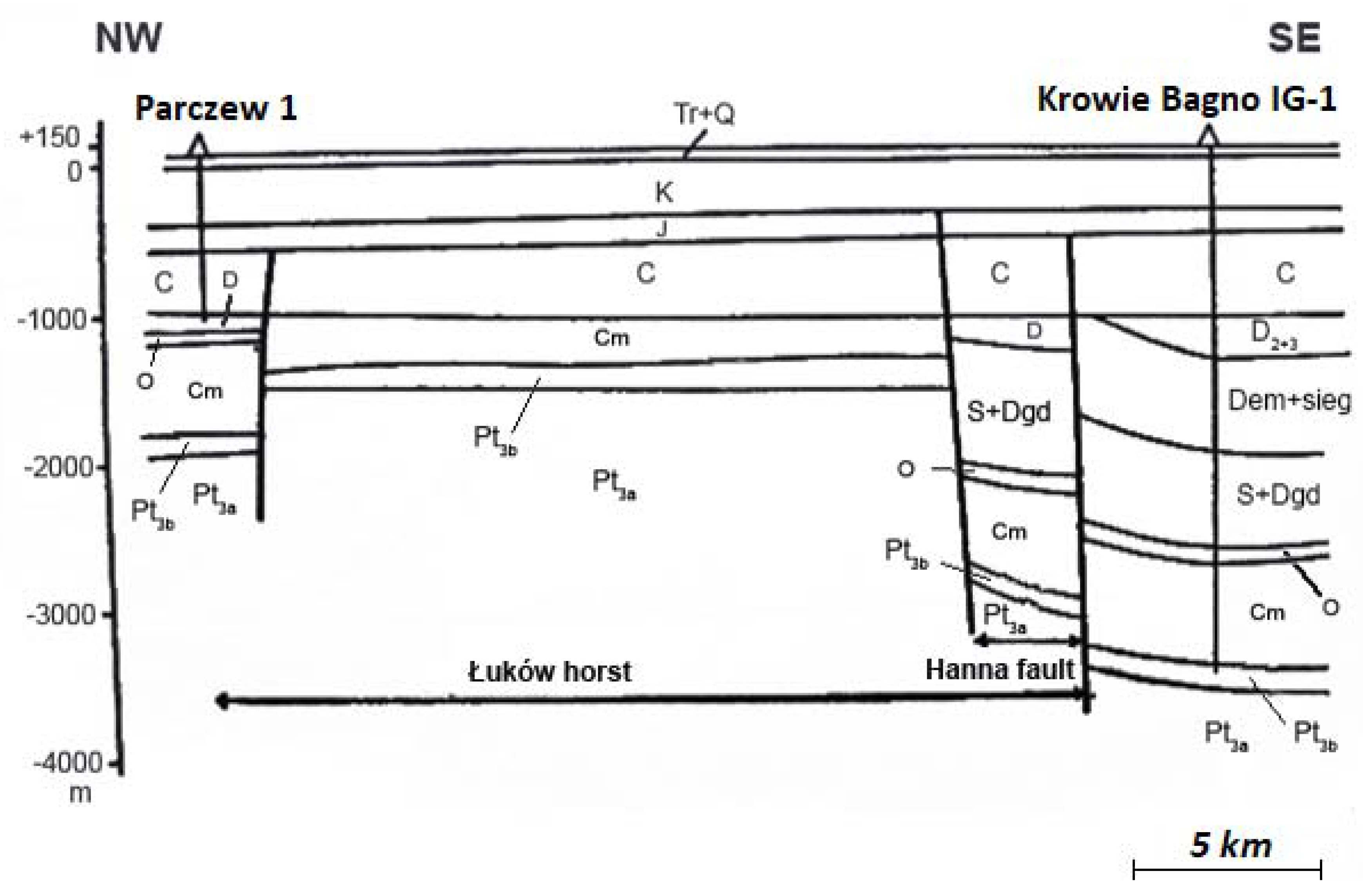
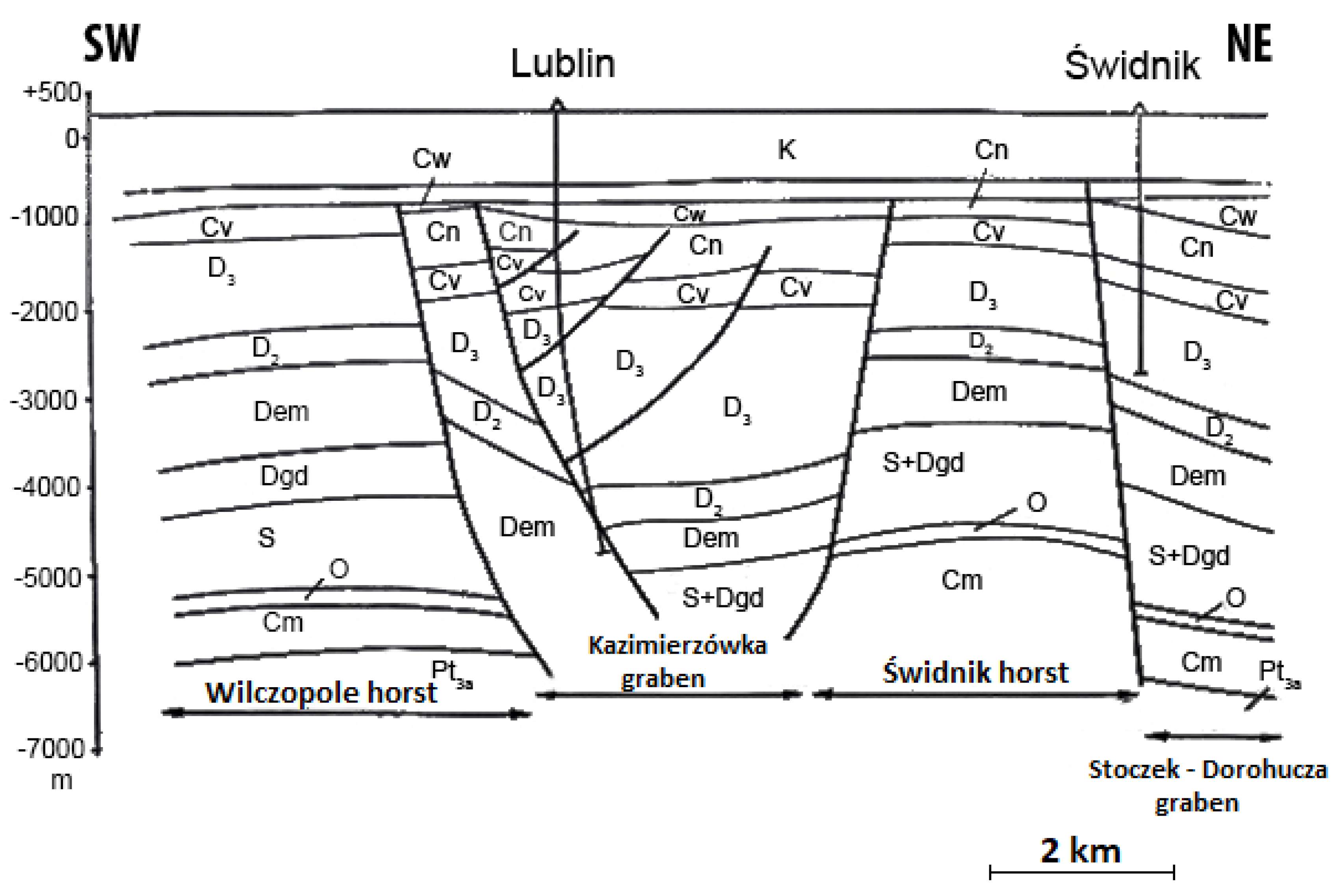
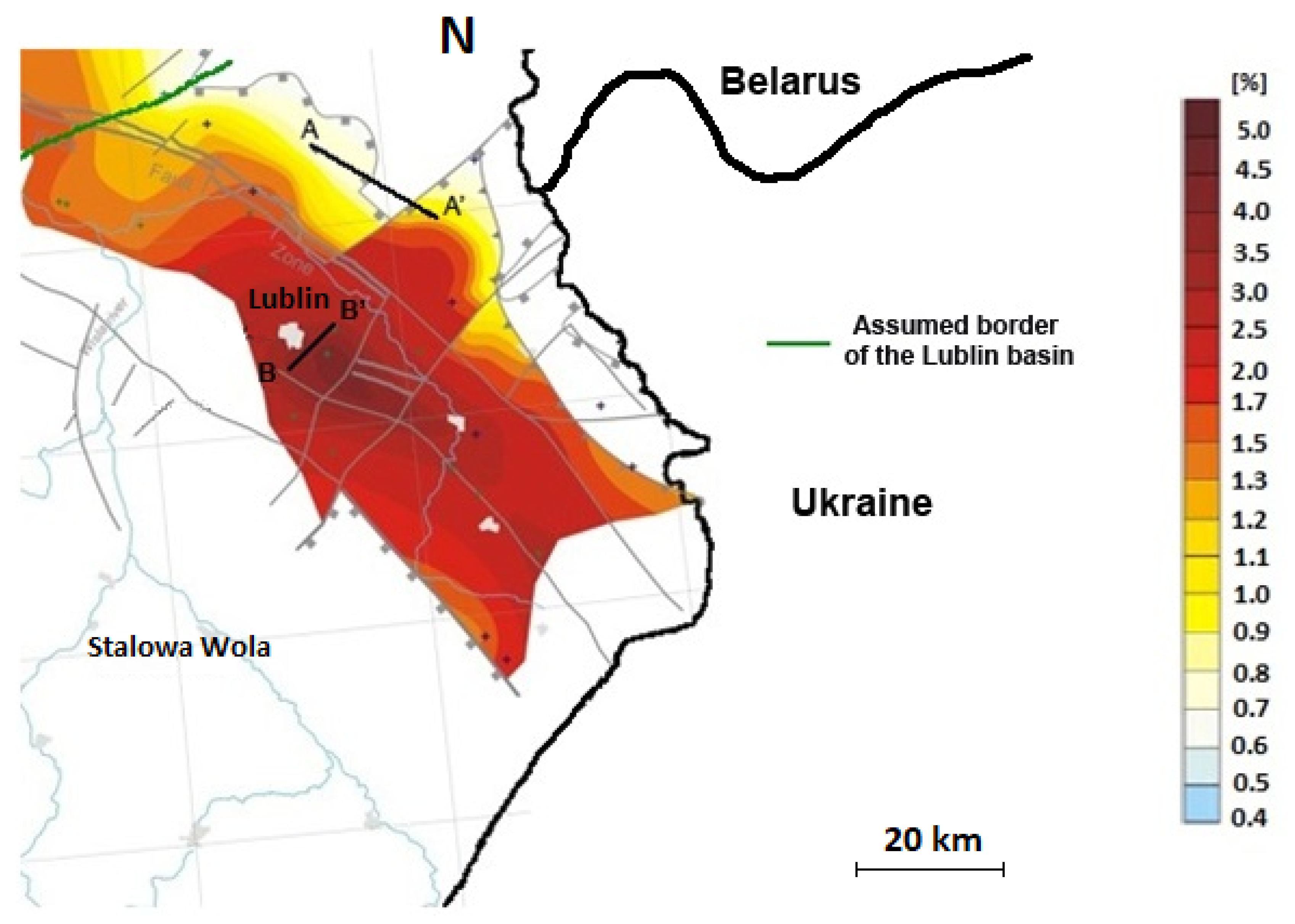
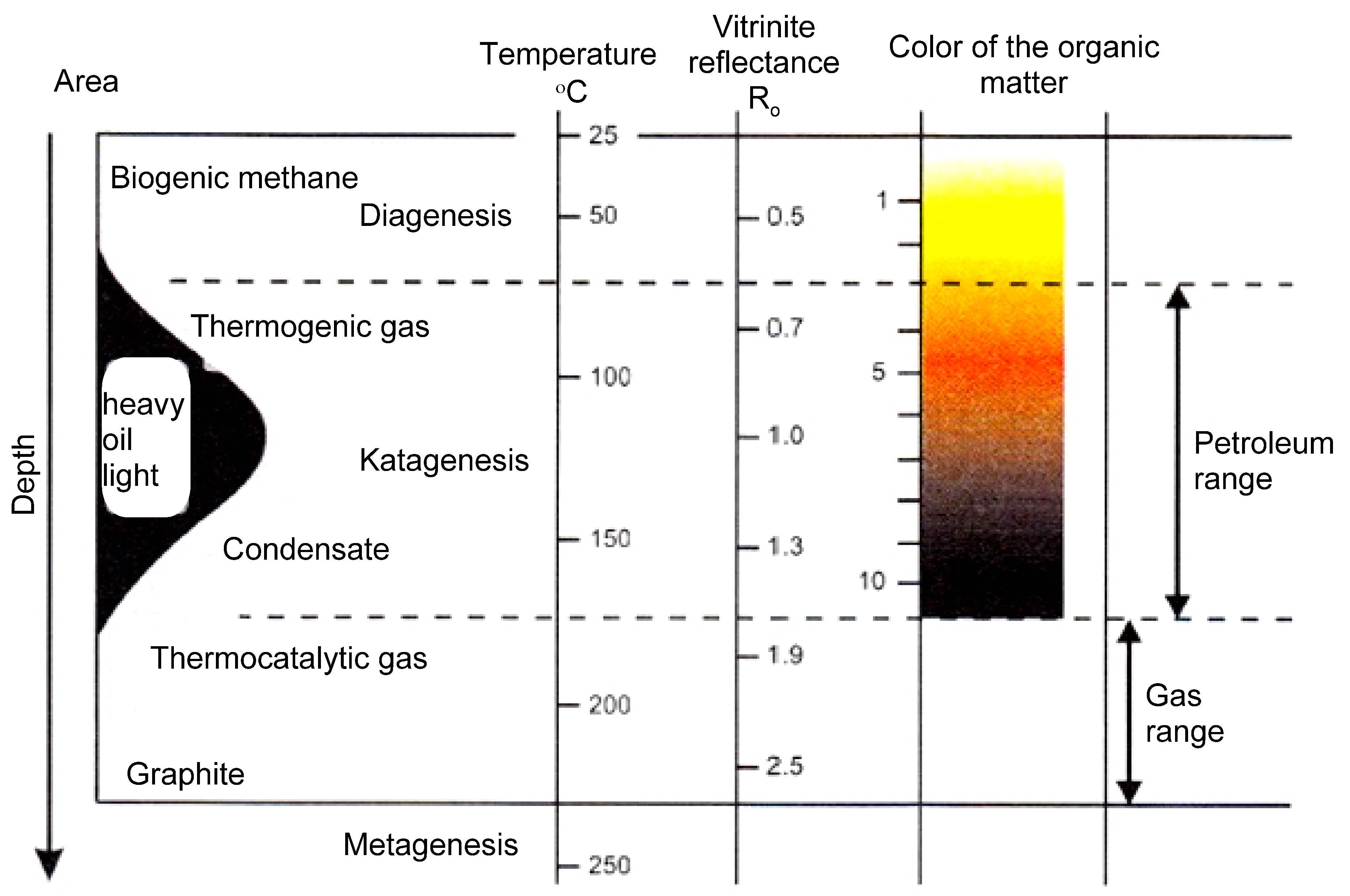
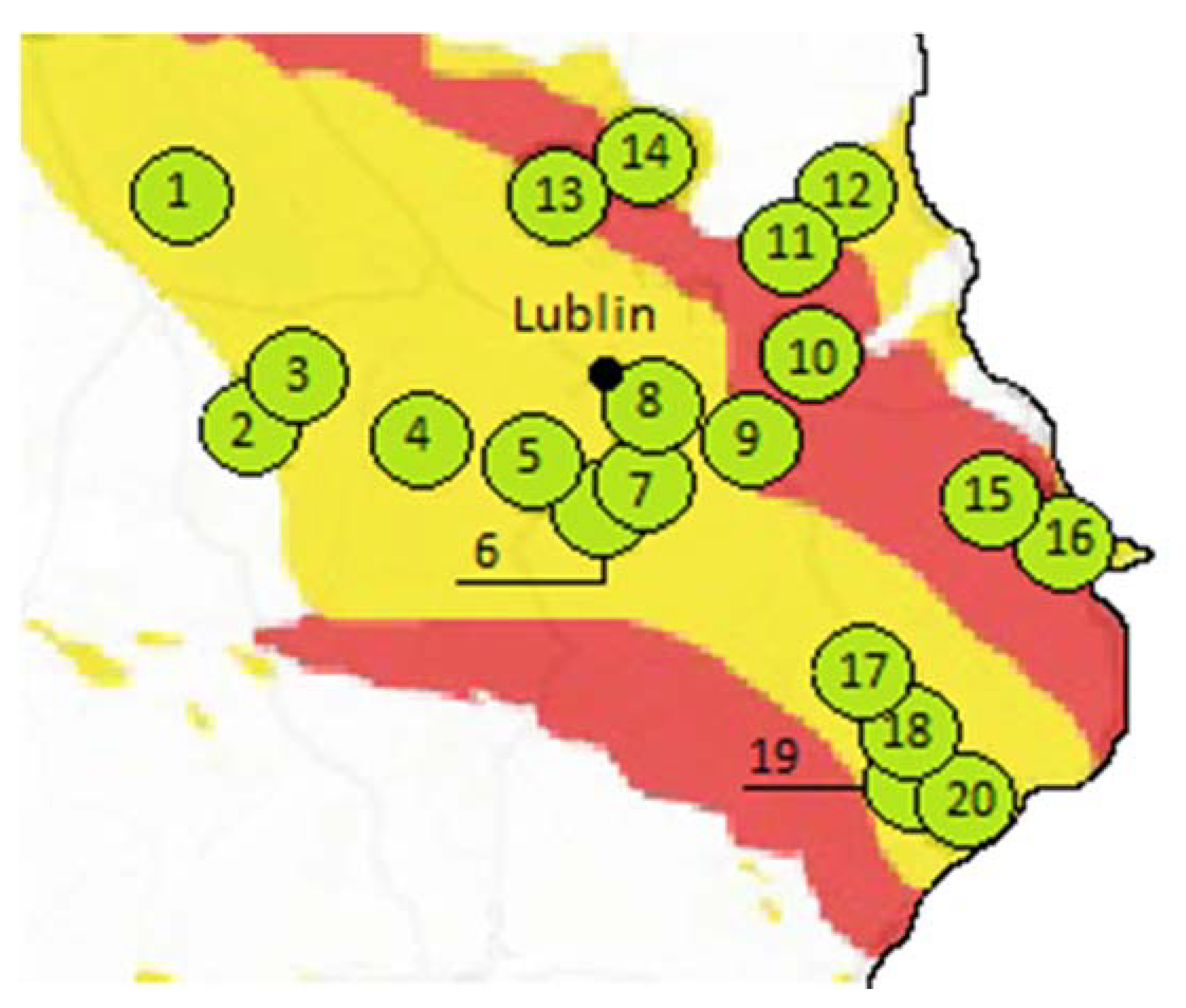
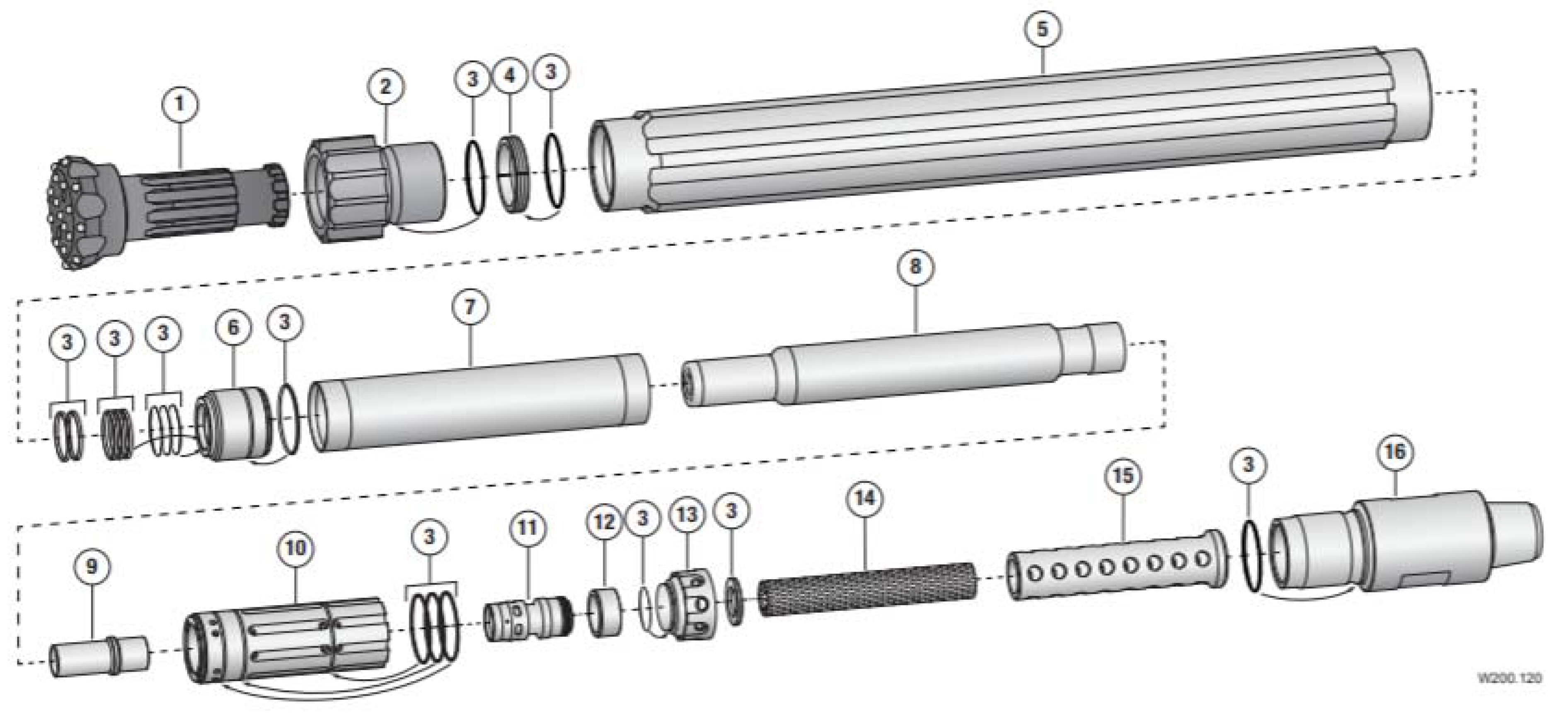

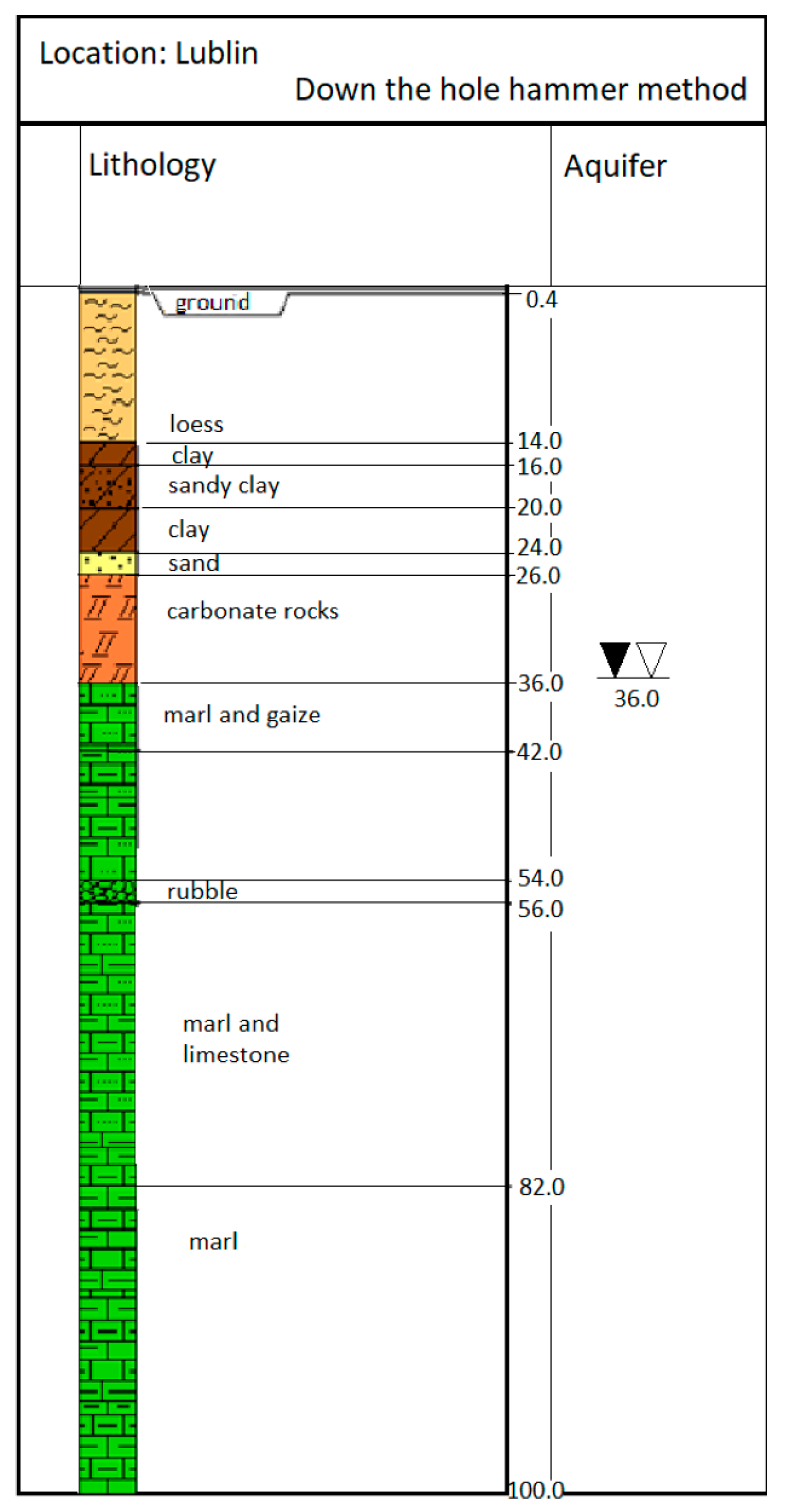
| Type of Rock | Density, g/cm3 | Uniaxial Compressive Strength, MN/cm2 |
|---|---|---|
| Granite | 2.60–2.90 | 20.0–38.0 |
| Diabase | 2.90–3.30 | 28.0–35.0 |
| Porphyry | 2.35–2.70 | 9.0–49.0 |
| Marble | 2.70–2.85 | 8.0–37.0 |
| Quartzite | 2.50–3.00 | 29.0–38.5 |
| Metamorphosed quartzite sandstone | 2.50–3.00 | 18.0–40.0 |
| Limestone | 1.50–3.00 | 2.0–20.0 |
| Dolomite | 2.20–2.70 | 6.0–27.0 |
| Quartzite sandstone | 2.00–3.00 | 12.0–35.0 |
| Rock salt | 2.10–2.20 | 2.5–4.0 |
| Sylvine | 2.00–2.20 | 2.5–4.0 |
| Type of Rock | Compressive Strength under Uniaxial Loading, MPa | Shear Stress for Rock Plastic Transition, MPa | Poisson’s Ratio |
|---|---|---|---|
| Loam | 5.0–150 | 0.1–3.0 | 0.45–0.50 |
| Hard coal | 20.0–30.0 | 75.0 | 0.20–0.25 |
| Rock salt | 25.0–40.0 | 24.0–50.0 | 0.35–0.40 |
| Anhydrite | 40.0–50.0 | 17.5 | 0.30–0.35 |
| Limestone | 15.0–40.0 | 35.0 | 0.40–0.45 |
| Marble | 55.0–70.0 | 52.5 | 0.20–0.25 |
| Sandy clayey shale | 60.0–80.0 | 70.0 | 0.20–0.25 |
| Clayey shale | 50.0–100.0 | 105.0 | 0.25–0.30 |
| Dolomite | 180.0–200.0 | 70.0 | 0.20–0.25 |
| Sandstone | 60.0–70.0 | 28.0 | 0.10–0.20 |
| Granite | 170.0–200.0 | 100.0 | 0.15–0.25 |
| Basalt | 220.0–340.0 | 105.0 | 0.20–0.25 |
Publisher’s Note: MDPI stays neutral with regard to jurisdictional claims in published maps and institutional affiliations. |
© 2021 by the authors. Licensee MDPI, Basel, Switzerland. This article is an open access article distributed under the terms and conditions of the Creative Commons Attribution (CC BY) license (https://creativecommons.org/licenses/by/4.0/).
Share and Cite
Sliwa, T.; Sapińska-Śliwa, A.; Korzec, M.; Gonet, A.; Jaszczur, M.; Ciepielowska, M.; Gajdosz, A. Investigation of Old Exploration Boreholes in the Lublin Basin with Regard to Potential Rotary-Percussion Drilling of Shale Gas Wells. Energies 2021, 14, 2734. https://doi.org/10.3390/en14102734
Sliwa T, Sapińska-Śliwa A, Korzec M, Gonet A, Jaszczur M, Ciepielowska M, Gajdosz A. Investigation of Old Exploration Boreholes in the Lublin Basin with Regard to Potential Rotary-Percussion Drilling of Shale Gas Wells. Energies. 2021; 14(10):2734. https://doi.org/10.3390/en14102734
Chicago/Turabian StyleSliwa, Tomasz, Aneta Sapińska-Śliwa, Michał Korzec, Andrzej Gonet, Marek Jaszczur, Martyna Ciepielowska, and Artur Gajdosz. 2021. "Investigation of Old Exploration Boreholes in the Lublin Basin with Regard to Potential Rotary-Percussion Drilling of Shale Gas Wells" Energies 14, no. 10: 2734. https://doi.org/10.3390/en14102734
APA StyleSliwa, T., Sapińska-Śliwa, A., Korzec, M., Gonet, A., Jaszczur, M., Ciepielowska, M., & Gajdosz, A. (2021). Investigation of Old Exploration Boreholes in the Lublin Basin with Regard to Potential Rotary-Percussion Drilling of Shale Gas Wells. Energies, 14(10), 2734. https://doi.org/10.3390/en14102734








